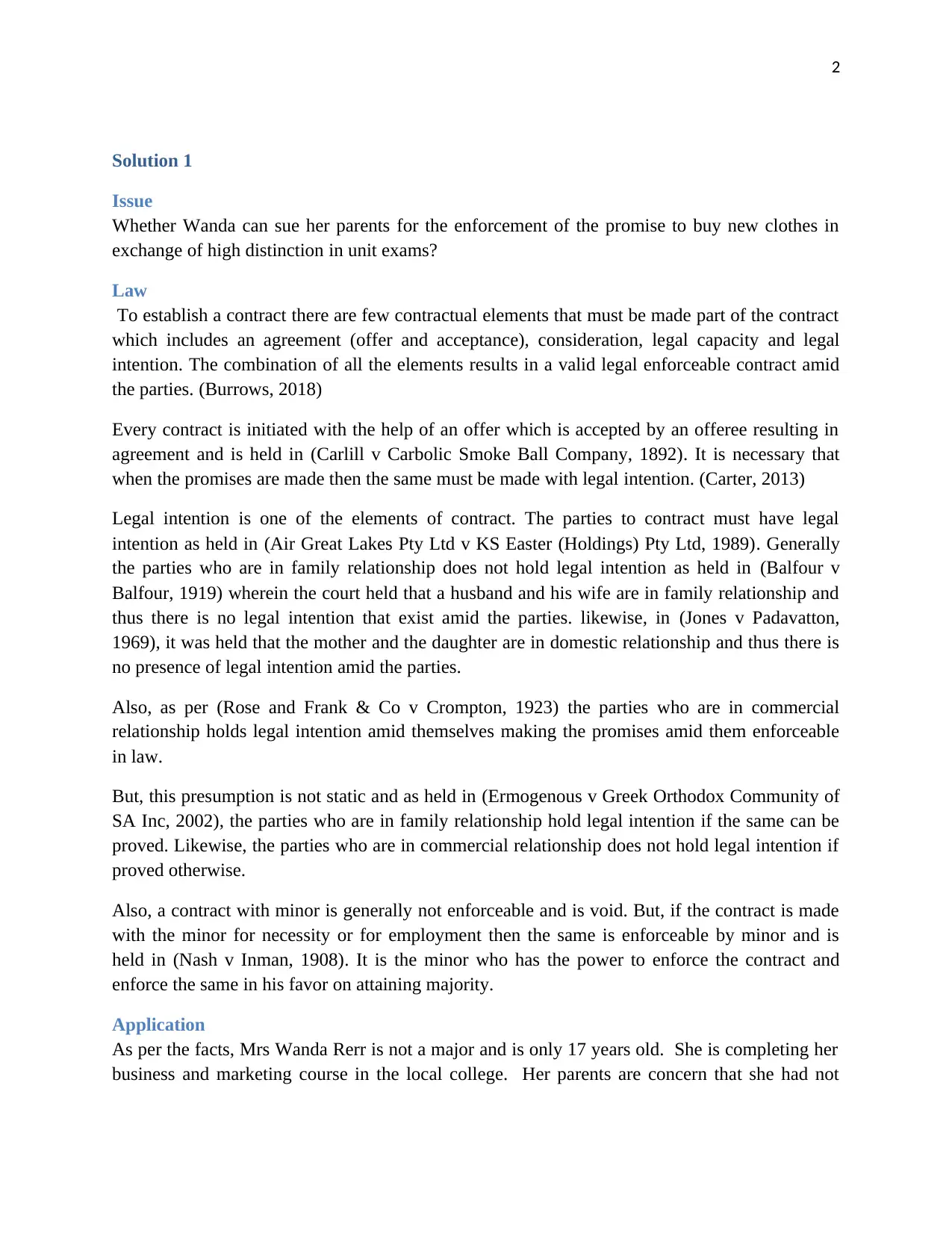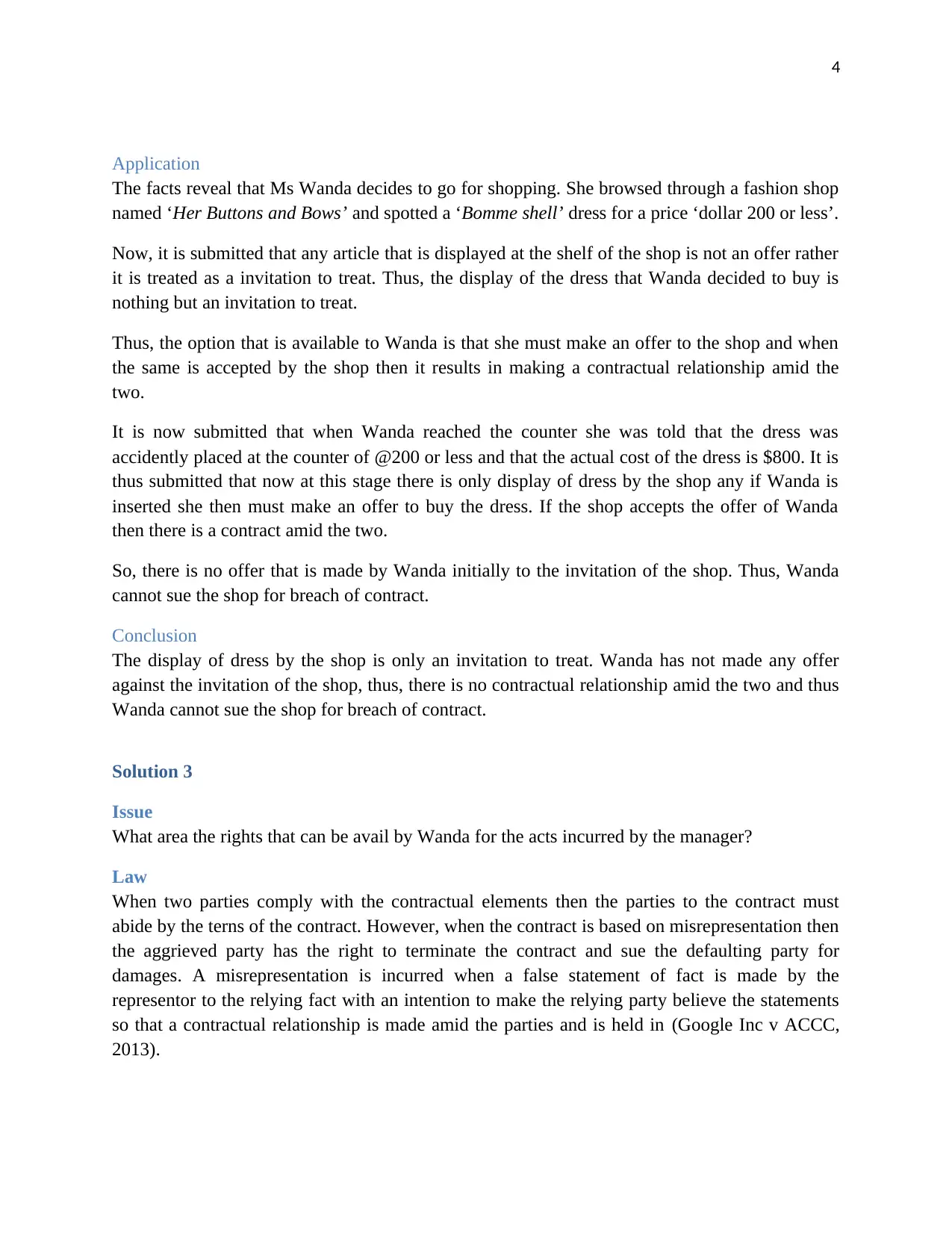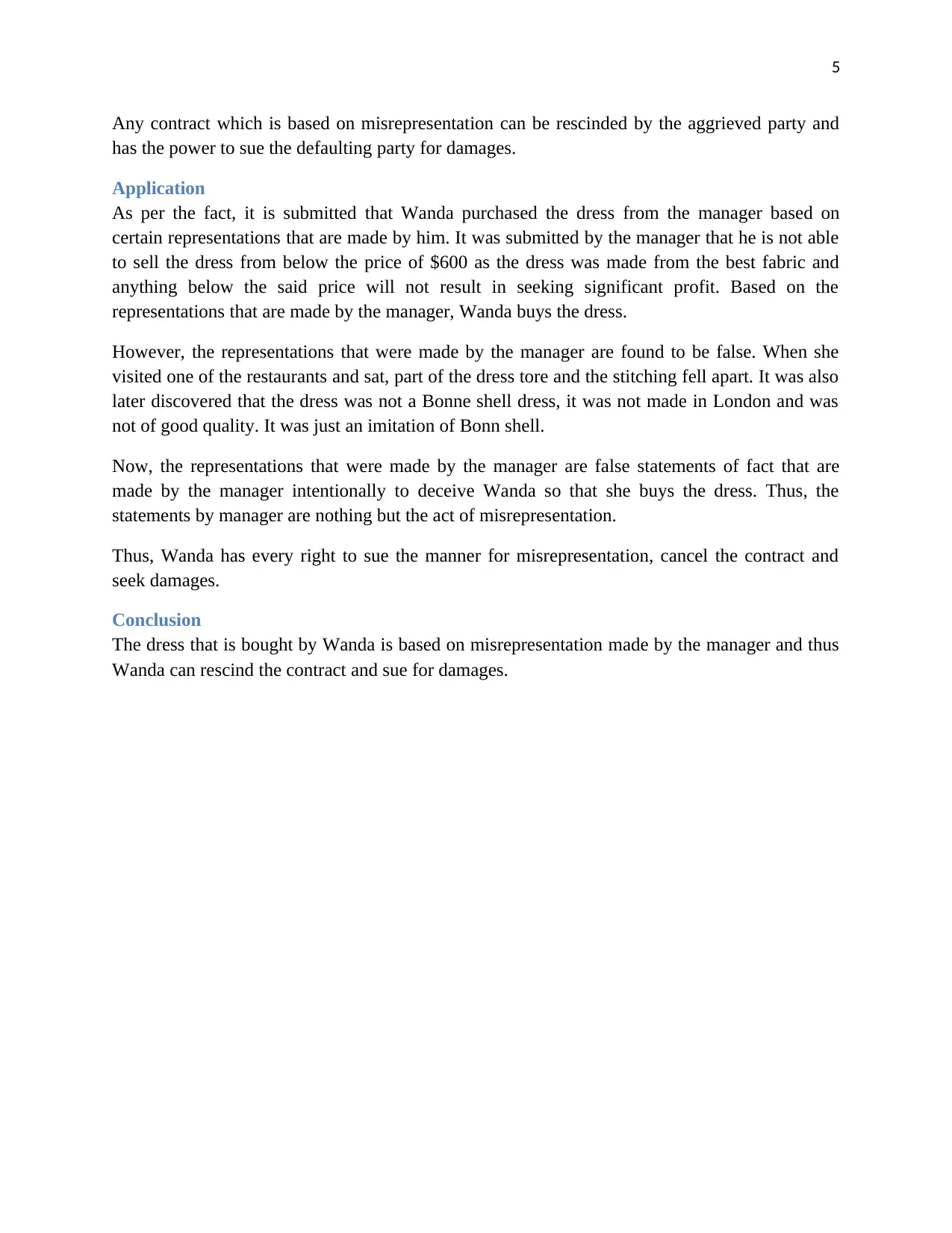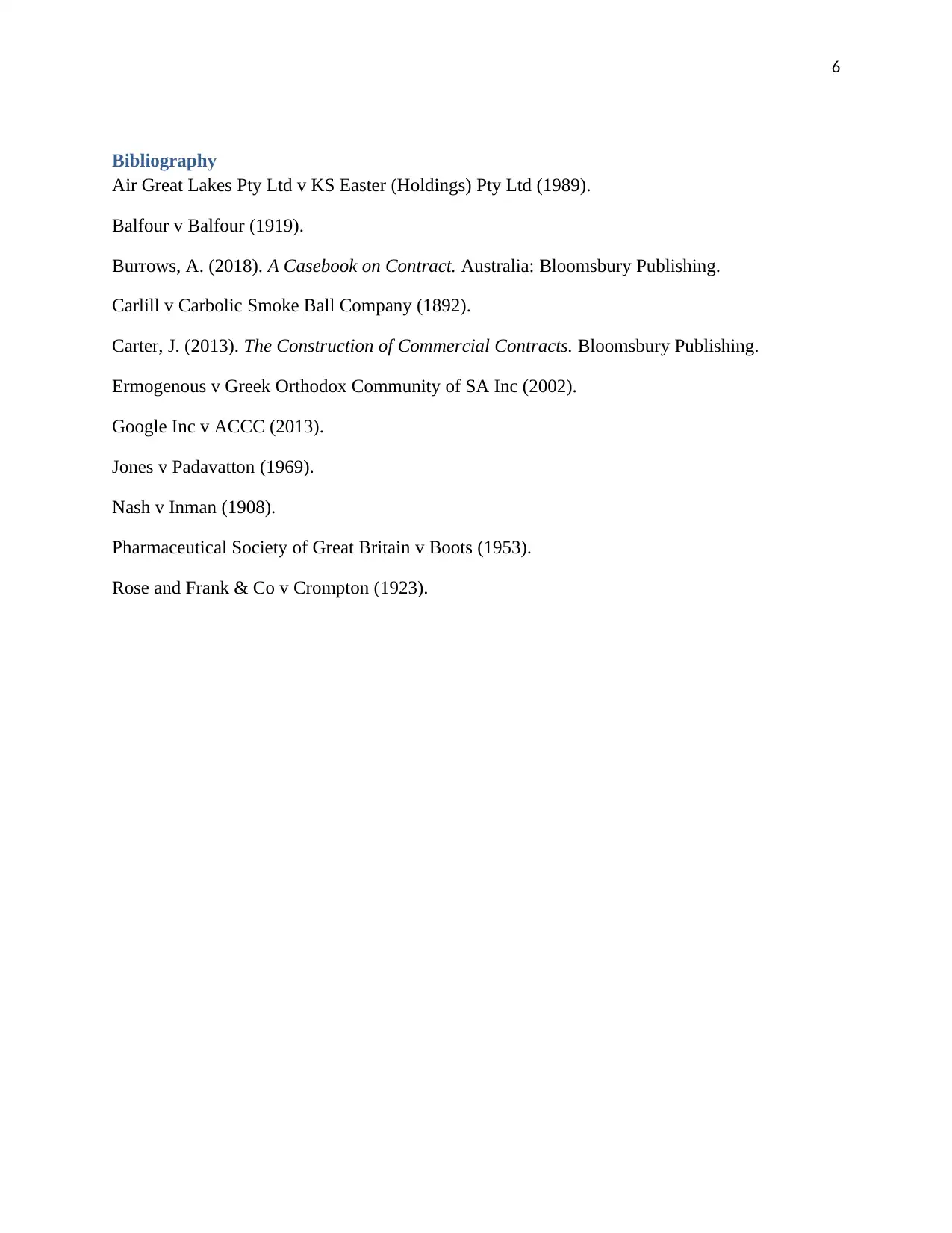Contract Law Analysis: Wanda's Rights in Fashion Purchase Disputes
VerifiedAdded on 2021/09/16
|6
|1851
|72
Case Study
AI Summary
This case study examines the contractual disputes faced by Wanda, a 17-year-old student. The analysis begins with Wanda's potential to sue her parents for failing to fulfill a promise to buy her clothes in exchange for good grades, exploring the legal principles of contract formation, including offer, acceptance, consideration, and legal intention, with a focus on family agreements and the enforceability of contracts involving minors. The second issue considers whether Wanda can sue a shop for breach of contract, analyzing the concepts of offers, invitations to treat, and the formation of agreements in a retail setting. Finally, the case study investigates Wanda's rights when purchasing a dress from a manager who made false representations about the dress's quality and origin, focusing on the legal implications of misrepresentation, rescission of contract, and the potential for damages. The case uses legal precedents to support its arguments.

1
Contents
Solution 1.........................................................................................................................................2
Issue.............................................................................................................................................2
Law...............................................................................................................................................2
Application...................................................................................................................................2
Conclusion...................................................................................................................................3
Solution 2.........................................................................................................................................3
Issue.............................................................................................................................................3
Law...............................................................................................................................................3
Application...................................................................................................................................4
Conclusion...................................................................................................................................4
Solution 3.........................................................................................................................................4
Issue.............................................................................................................................................4
Law...............................................................................................................................................4
Application...................................................................................................................................5
Conclusion...................................................................................................................................5
Bibliography....................................................................................................................................6
Contents
Solution 1.........................................................................................................................................2
Issue.............................................................................................................................................2
Law...............................................................................................................................................2
Application...................................................................................................................................2
Conclusion...................................................................................................................................3
Solution 2.........................................................................................................................................3
Issue.............................................................................................................................................3
Law...............................................................................................................................................3
Application...................................................................................................................................4
Conclusion...................................................................................................................................4
Solution 3.........................................................................................................................................4
Issue.............................................................................................................................................4
Law...............................................................................................................................................4
Application...................................................................................................................................5
Conclusion...................................................................................................................................5
Bibliography....................................................................................................................................6
Paraphrase This Document
Need a fresh take? Get an instant paraphrase of this document with our AI Paraphraser

2
Solution 1
Issue
Whether Wanda can sue her parents for the enforcement of the promise to buy new clothes in
exchange of high distinction in unit exams?
Law
To establish a contract there are few contractual elements that must be made part of the contract
which includes an agreement (offer and acceptance), consideration, legal capacity and legal
intention. The combination of all the elements results in a valid legal enforceable contract amid
the parties. (Burrows, 2018)
Every contract is initiated with the help of an offer which is accepted by an offeree resulting in
agreement and is held in (Carlill v Carbolic Smoke Ball Company, 1892). It is necessary that
when the promises are made then the same must be made with legal intention. (Carter, 2013)
Legal intention is one of the elements of contract. The parties to contract must have legal
intention as held in (Air Great Lakes Pty Ltd v KS Easter (Holdings) Pty Ltd, 1989). Generally
the parties who are in family relationship does not hold legal intention as held in (Balfour v
Balfour, 1919) wherein the court held that a husband and his wife are in family relationship and
thus there is no legal intention that exist amid the parties. likewise, in (Jones v Padavatton,
1969), it was held that the mother and the daughter are in domestic relationship and thus there is
no presence of legal intention amid the parties.
Also, as per (Rose and Frank & Co v Crompton, 1923) the parties who are in commercial
relationship holds legal intention amid themselves making the promises amid them enforceable
in law.
But, this presumption is not static and as held in (Ermogenous v Greek Orthodox Community of
SA Inc, 2002), the parties who are in family relationship hold legal intention if the same can be
proved. Likewise, the parties who are in commercial relationship does not hold legal intention if
proved otherwise.
Also, a contract with minor is generally not enforceable and is void. But, if the contract is made
with the minor for necessity or for employment then the same is enforceable by minor and is
held in (Nash v Inman, 1908). It is the minor who has the power to enforce the contract and
enforce the same in his favor on attaining majority.
Application
As per the facts, Mrs Wanda Rerr is not a major and is only 17 years old. She is completing her
business and marketing course in the local college. Her parents are concern that she had not
Solution 1
Issue
Whether Wanda can sue her parents for the enforcement of the promise to buy new clothes in
exchange of high distinction in unit exams?
Law
To establish a contract there are few contractual elements that must be made part of the contract
which includes an agreement (offer and acceptance), consideration, legal capacity and legal
intention. The combination of all the elements results in a valid legal enforceable contract amid
the parties. (Burrows, 2018)
Every contract is initiated with the help of an offer which is accepted by an offeree resulting in
agreement and is held in (Carlill v Carbolic Smoke Ball Company, 1892). It is necessary that
when the promises are made then the same must be made with legal intention. (Carter, 2013)
Legal intention is one of the elements of contract. The parties to contract must have legal
intention as held in (Air Great Lakes Pty Ltd v KS Easter (Holdings) Pty Ltd, 1989). Generally
the parties who are in family relationship does not hold legal intention as held in (Balfour v
Balfour, 1919) wherein the court held that a husband and his wife are in family relationship and
thus there is no legal intention that exist amid the parties. likewise, in (Jones v Padavatton,
1969), it was held that the mother and the daughter are in domestic relationship and thus there is
no presence of legal intention amid the parties.
Also, as per (Rose and Frank & Co v Crompton, 1923) the parties who are in commercial
relationship holds legal intention amid themselves making the promises amid them enforceable
in law.
But, this presumption is not static and as held in (Ermogenous v Greek Orthodox Community of
SA Inc, 2002), the parties who are in family relationship hold legal intention if the same can be
proved. Likewise, the parties who are in commercial relationship does not hold legal intention if
proved otherwise.
Also, a contract with minor is generally not enforceable and is void. But, if the contract is made
with the minor for necessity or for employment then the same is enforceable by minor and is
held in (Nash v Inman, 1908). It is the minor who has the power to enforce the contract and
enforce the same in his favor on attaining majority.
Application
As per the facts, Mrs Wanda Rerr is not a major and is only 17 years old. She is completing her
business and marketing course in the local college. Her parents are concern that she had not

3
studied hard for the unit. Her parents promised her that if she will get a High distinction in her
unit then they will buy her clothes of $3000.
It is submitted that both Wanda and her parents are in the relationship of family and are
domestically united. Thus, as per (Balfour v Balfour, 1919)there cannot be any kind of
contractual relationship amid the two. It is presumed that there is absence of legal intention amid
them and thus there is no contractual relationship amid them.
But, if the parties who are in family relationship exchange promises with the legal intention to
abide by the same, then, such promises are enforceable in law as held in (Ermogenous v Greek
Orthodox Community of SA Inc, 2002)
As stated, that based on the said promise, Wanda studied very hard and get high distinction in
her exams. Now, the parents cannot refuse to buy her new clothes. This is because the hard study
of Wanda is based on the promise made by her parents. Thus, the parties are willing to abide by
the promises that are exchanged amid them even though they are sharing family relationship.
Also, the contact that is made by the parents of Wanda is when she is a minor and the same is
made for her necessity. Thus, as per (Nash v Inman, 1908)Wanda has the right to sue her parents
and enforce the promises that are exchanged amid them.
Conclusion
Thus, Wanda can sue her parents for the enforcement of contract and persuade them to buy her
new clothes worth $ 3000. Since she a minor and the contract is made for her necessity, thus, the
contract is valid.
Solution 2
Issue
Whether Wanda can sue the seller for breach of contract?
Law
Any contract can come into existence when there is a valid offer made by the offeror which must
be accepted by the offeree. An offer is the communication of the intention of the offeror either
verbally or textually to the offeree. The offeree when affirms the terms that is communicated to
him without any variation then it is an acceptance in law and is held in (Carlill v Carbolic Smoke
Ball Company, 1892). Both offer and acceptance results in the formation of an agreement.
An invitation is different from an acceptance wherein the person making the invitation invites
offer from the respective person which when affirms by the inviter (offeree) results in binding
agreement amid the parties. An advertisement, display of goods at the shelf is not offers but are
invitation to treat and is held in (Pharmaceutical Society of Great Britain v Boots, 1953).
studied hard for the unit. Her parents promised her that if she will get a High distinction in her
unit then they will buy her clothes of $3000.
It is submitted that both Wanda and her parents are in the relationship of family and are
domestically united. Thus, as per (Balfour v Balfour, 1919)there cannot be any kind of
contractual relationship amid the two. It is presumed that there is absence of legal intention amid
them and thus there is no contractual relationship amid them.
But, if the parties who are in family relationship exchange promises with the legal intention to
abide by the same, then, such promises are enforceable in law as held in (Ermogenous v Greek
Orthodox Community of SA Inc, 2002)
As stated, that based on the said promise, Wanda studied very hard and get high distinction in
her exams. Now, the parents cannot refuse to buy her new clothes. This is because the hard study
of Wanda is based on the promise made by her parents. Thus, the parties are willing to abide by
the promises that are exchanged amid them even though they are sharing family relationship.
Also, the contact that is made by the parents of Wanda is when she is a minor and the same is
made for her necessity. Thus, as per (Nash v Inman, 1908)Wanda has the right to sue her parents
and enforce the promises that are exchanged amid them.
Conclusion
Thus, Wanda can sue her parents for the enforcement of contract and persuade them to buy her
new clothes worth $ 3000. Since she a minor and the contract is made for her necessity, thus, the
contract is valid.
Solution 2
Issue
Whether Wanda can sue the seller for breach of contract?
Law
Any contract can come into existence when there is a valid offer made by the offeror which must
be accepted by the offeree. An offer is the communication of the intention of the offeror either
verbally or textually to the offeree. The offeree when affirms the terms that is communicated to
him without any variation then it is an acceptance in law and is held in (Carlill v Carbolic Smoke
Ball Company, 1892). Both offer and acceptance results in the formation of an agreement.
An invitation is different from an acceptance wherein the person making the invitation invites
offer from the respective person which when affirms by the inviter (offeree) results in binding
agreement amid the parties. An advertisement, display of goods at the shelf is not offers but are
invitation to treat and is held in (Pharmaceutical Society of Great Britain v Boots, 1953).
⊘ This is a preview!⊘
Do you want full access?
Subscribe today to unlock all pages.

Trusted by 1+ million students worldwide

4
Application
The facts reveal that Ms Wanda decides to go for shopping. She browsed through a fashion shop
named ‘Her Buttons and Bows’ and spotted a ‘Bomme shell’ dress for a price ‘dollar 200 or less’.
Now, it is submitted that any article that is displayed at the shelf of the shop is not an offer rather
it is treated as a invitation to treat. Thus, the display of the dress that Wanda decided to buy is
nothing but an invitation to treat.
Thus, the option that is available to Wanda is that she must make an offer to the shop and when
the same is accepted by the shop then it results in making a contractual relationship amid the
two.
It is now submitted that when Wanda reached the counter she was told that the dress was
accidently placed at the counter of @200 or less and that the actual cost of the dress is $800. It is
thus submitted that now at this stage there is only display of dress by the shop any if Wanda is
inserted she then must make an offer to buy the dress. If the shop accepts the offer of Wanda
then there is a contract amid the two.
So, there is no offer that is made by Wanda initially to the invitation of the shop. Thus, Wanda
cannot sue the shop for breach of contract.
Conclusion
The display of dress by the shop is only an invitation to treat. Wanda has not made any offer
against the invitation of the shop, thus, there is no contractual relationship amid the two and thus
Wanda cannot sue the shop for breach of contract.
Solution 3
Issue
What area the rights that can be avail by Wanda for the acts incurred by the manager?
Law
When two parties comply with the contractual elements then the parties to the contract must
abide by the terns of the contract. However, when the contract is based on misrepresentation then
the aggrieved party has the right to terminate the contract and sue the defaulting party for
damages. A misrepresentation is incurred when a false statement of fact is made by the
representor to the relying fact with an intention to make the relying party believe the statements
so that a contractual relationship is made amid the parties and is held in (Google Inc v ACCC,
2013).
Application
The facts reveal that Ms Wanda decides to go for shopping. She browsed through a fashion shop
named ‘Her Buttons and Bows’ and spotted a ‘Bomme shell’ dress for a price ‘dollar 200 or less’.
Now, it is submitted that any article that is displayed at the shelf of the shop is not an offer rather
it is treated as a invitation to treat. Thus, the display of the dress that Wanda decided to buy is
nothing but an invitation to treat.
Thus, the option that is available to Wanda is that she must make an offer to the shop and when
the same is accepted by the shop then it results in making a contractual relationship amid the
two.
It is now submitted that when Wanda reached the counter she was told that the dress was
accidently placed at the counter of @200 or less and that the actual cost of the dress is $800. It is
thus submitted that now at this stage there is only display of dress by the shop any if Wanda is
inserted she then must make an offer to buy the dress. If the shop accepts the offer of Wanda
then there is a contract amid the two.
So, there is no offer that is made by Wanda initially to the invitation of the shop. Thus, Wanda
cannot sue the shop for breach of contract.
Conclusion
The display of dress by the shop is only an invitation to treat. Wanda has not made any offer
against the invitation of the shop, thus, there is no contractual relationship amid the two and thus
Wanda cannot sue the shop for breach of contract.
Solution 3
Issue
What area the rights that can be avail by Wanda for the acts incurred by the manager?
Law
When two parties comply with the contractual elements then the parties to the contract must
abide by the terns of the contract. However, when the contract is based on misrepresentation then
the aggrieved party has the right to terminate the contract and sue the defaulting party for
damages. A misrepresentation is incurred when a false statement of fact is made by the
representor to the relying fact with an intention to make the relying party believe the statements
so that a contractual relationship is made amid the parties and is held in (Google Inc v ACCC,
2013).
Paraphrase This Document
Need a fresh take? Get an instant paraphrase of this document with our AI Paraphraser

5
Any contract which is based on misrepresentation can be rescinded by the aggrieved party and
has the power to sue the defaulting party for damages.
Application
As per the fact, it is submitted that Wanda purchased the dress from the manager based on
certain representations that are made by him. It was submitted by the manager that he is not able
to sell the dress from below the price of $600 as the dress was made from the best fabric and
anything below the said price will not result in seeking significant profit. Based on the
representations that are made by the manager, Wanda buys the dress.
However, the representations that were made by the manager are found to be false. When she
visited one of the restaurants and sat, part of the dress tore and the stitching fell apart. It was also
later discovered that the dress was not a Bonne shell dress, it was not made in London and was
not of good quality. It was just an imitation of Bonn shell.
Now, the representations that were made by the manager are false statements of fact that are
made by the manager intentionally to deceive Wanda so that she buys the dress. Thus, the
statements by manager are nothing but the act of misrepresentation.
Thus, Wanda has every right to sue the manner for misrepresentation, cancel the contract and
seek damages.
Conclusion
The dress that is bought by Wanda is based on misrepresentation made by the manager and thus
Wanda can rescind the contract and sue for damages.
Any contract which is based on misrepresentation can be rescinded by the aggrieved party and
has the power to sue the defaulting party for damages.
Application
As per the fact, it is submitted that Wanda purchased the dress from the manager based on
certain representations that are made by him. It was submitted by the manager that he is not able
to sell the dress from below the price of $600 as the dress was made from the best fabric and
anything below the said price will not result in seeking significant profit. Based on the
representations that are made by the manager, Wanda buys the dress.
However, the representations that were made by the manager are found to be false. When she
visited one of the restaurants and sat, part of the dress tore and the stitching fell apart. It was also
later discovered that the dress was not a Bonne shell dress, it was not made in London and was
not of good quality. It was just an imitation of Bonn shell.
Now, the representations that were made by the manager are false statements of fact that are
made by the manager intentionally to deceive Wanda so that she buys the dress. Thus, the
statements by manager are nothing but the act of misrepresentation.
Thus, Wanda has every right to sue the manner for misrepresentation, cancel the contract and
seek damages.
Conclusion
The dress that is bought by Wanda is based on misrepresentation made by the manager and thus
Wanda can rescind the contract and sue for damages.

6
Bibliography
Air Great Lakes Pty Ltd v KS Easter (Holdings) Pty Ltd (1989).
Balfour v Balfour (1919).
Burrows, A. (2018). A Casebook on Contract. Australia: Bloomsbury Publishing.
Carlill v Carbolic Smoke Ball Company (1892).
Carter, J. (2013). The Construction of Commercial Contracts. Bloomsbury Publishing.
Ermogenous v Greek Orthodox Community of SA Inc (2002).
Google Inc v ACCC (2013).
Jones v Padavatton (1969).
Nash v Inman (1908).
Pharmaceutical Society of Great Britain v Boots (1953).
Rose and Frank & Co v Crompton (1923).
Bibliography
Air Great Lakes Pty Ltd v KS Easter (Holdings) Pty Ltd (1989).
Balfour v Balfour (1919).
Burrows, A. (2018). A Casebook on Contract. Australia: Bloomsbury Publishing.
Carlill v Carbolic Smoke Ball Company (1892).
Carter, J. (2013). The Construction of Commercial Contracts. Bloomsbury Publishing.
Ermogenous v Greek Orthodox Community of SA Inc (2002).
Google Inc v ACCC (2013).
Jones v Padavatton (1969).
Nash v Inman (1908).
Pharmaceutical Society of Great Britain v Boots (1953).
Rose and Frank & Co v Crompton (1923).
⊘ This is a preview!⊘
Do you want full access?
Subscribe today to unlock all pages.

Trusted by 1+ million students worldwide
1 out of 6
Related Documents
Your All-in-One AI-Powered Toolkit for Academic Success.
+13062052269
info@desklib.com
Available 24*7 on WhatsApp / Email
![[object Object]](/_next/static/media/star-bottom.7253800d.svg)
Unlock your academic potential
Copyright © 2020–2025 A2Z Services. All Rights Reserved. Developed and managed by ZUCOL.




